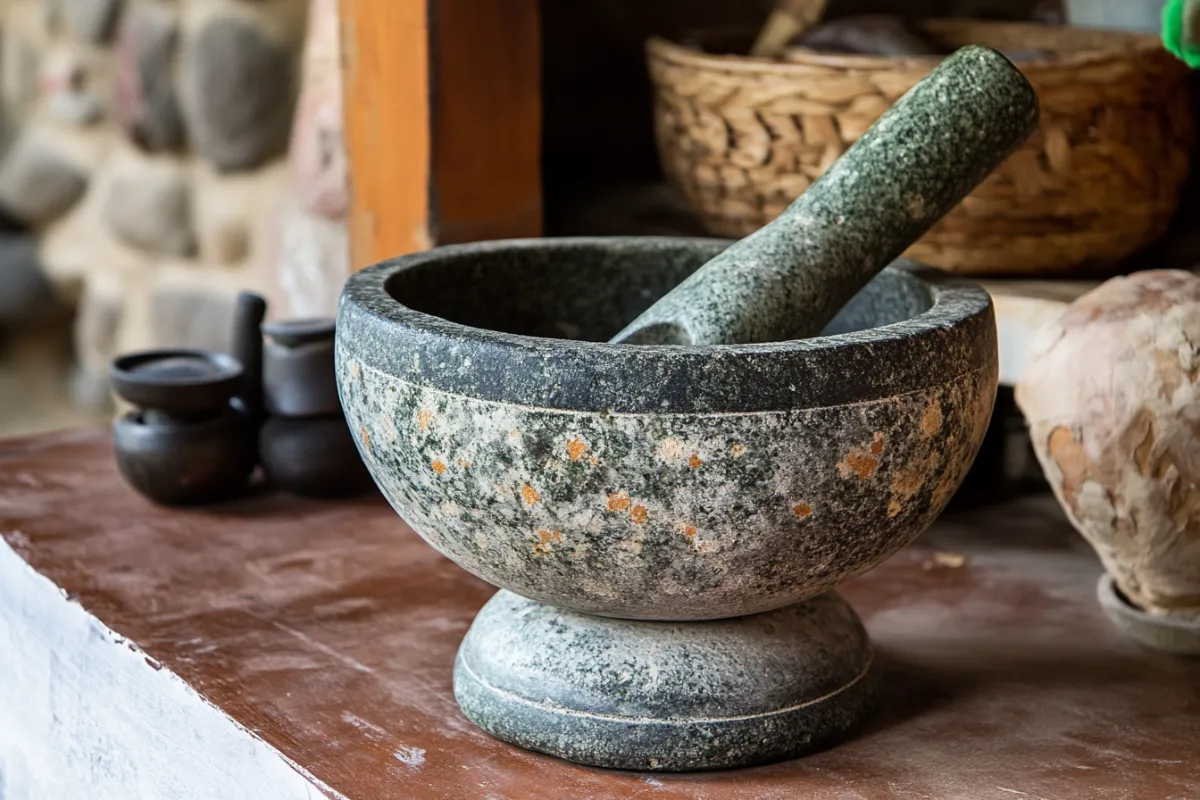What Is a Real Molcajete?
Introduction to the Real Molcajete
The molcajete, a traditional Mexican mortar and pestle made from volcanic stone, has been an essential part of Mexican kitchens for centuries. This age-old tool, used primarily for grinding spices, preparing salsas, guacamole, and sauces, has a unique ability to extract maximum flavor from ingredients. But when we talk about a real molcajete, we refer to one made from authentic volcanic basalt rock, hand-carved by artisans with exceptional craftsmanship.
However, in recent times, due to its popularity, imitation molcajetes made of cement, resin, and other inferior materials have flooded the market. These imitations not only compromise on functionality but also lack the cultural significance of an authentic molcajete. Understanding the difference between an authentic and fake molcajete is essential for anyone interested in preserving the true essence of Mexican cuisine.
In this article, we will explore in depth what makes a molcajete real, its history, the materials used, the artisanal craftsmanship involved, and why it stands apart from modern kitchen appliances. You will also learn how to identify a genuine molcajete and why investing in one can transform your cooking.
History of the Molcajete
The molcajete has its roots deep in Mesoamerican culture, with evidence suggesting that it has been in use for more than 2,000 years. The term molcajete comes from the Nahuatl language, spoken by the Aztecs, and translates roughly to “sauce bowl.” Early molcajetes were made using volcanic stone, and they played a crucial role in preparing food, especially for rituals and communal feasts.
The Metate and Molcajete Connection
The molcajete evolved from the metate, another stone tool used for grinding grains, particularly maize. While the metate was larger and used for bulk processing, the molcajete became a more portable and versatile tool for smaller food preparations. Over the centuries, the molcajete has retained its cultural significance and remains a vital tool in Mexican households and restaurants.
For a more detailed look at the evolution and cultural significance of the molcajete, you can explore this Ultimate Guide to the Molcajete.
What Makes a Real Molcajete?
Materials: The Power of Volcanic Stone
An authentic molcajete is made from basalt, a type of volcanic rock. The choice of basalt is key because it provides the perfect rough texture for grinding ingredients, allowing them to break down efficiently and release their full flavors. This is a major advantage of real molcajetes over modern kitchen tools such as blenders, which often crush ingredients too finely or blend them too quickly, diminishing the taste.
Volcanic stone also offers durability. A real molcajete, if cared for properly, can last for decades, often being passed down from one generation to the next. The material is porous, which is why the molcajete needs to be seasoned properly before its first use (more on that later).
Hand-Carved Craftsmanship
A real molcajete is not just a tool; it’s a work of art. Many molcajetes are hand-carved by skilled artisans in Mexico, particularly in small towns like San Salvador El Seco in Puebla. These artisans use techniques passed down through generations to shape the volcanic stone into a molcajete. Every genuine molcajete is unique, with slight variations that give it character and ensure its authenticity.
The process is labor-intensive, as artisans must select the right stone, carve it into the bowl and pestle, and polish it to create the perfect grinding surface. The craftsmanship involved makes each molcajete special and drives up the price, but it also ensures quality and longevity.
For more on the value and cost of authentic molcajetes, you can refer to Why is Molcajete So Expensive?.
How to Identify a Real Molcajete
With so many imitations available, how can you identify a real molcajete? Here are a few practical tests you can perform:
1. The Texture Test
The surface of a real molcajete should be rough and porous. This roughness is what makes the molcajete so effective at grinding. If the surface is too smooth, it may indicate that the molcajete is made from cement or a similar material, which won’t grind ingredients properly.
2. The Weight Test
A genuine molcajete is quite heavy due to the density of volcanic rock. If the molcajete feels too light, it could be a fake made from a lighter material, like concrete or resin.
3. The Water Absorption Test
Pour a little water into the molcajete and observe how it behaves. A real volcanic stone molcajete will hold the water without soaking it up, while a concrete or cement imitation will often absorb the water into the surface.
4. The Scratch Test
You can lightly scratch the surface of the molcajete with a metal object, like a knife. If the surface scratches easily, it might be made from a softer material, such as cement, which is a clear indicator of a fake.
For more detailed tips on identifying authentic molcajetes, check out What is a Molcajete Dish?.
The Process of Curing and Seasoning a New Molcajete
Before you can use a new molcajete, it must be cured or seasoned to remove any small particles of stone and smooth the grinding surface. Here’s how to properly cure your molcajete:
- The Rice Test: Start by grinding dry rice in the molcajete. As you grind, the rice will pick up small particles of stone. Repeat this process until the rice remains white and does not turn gray.
- Garlic and Salt Seasoning: Once the rice test is complete, you can season the molcajete by grinding a mixture of garlic, salt, and some herbs. This not only smooths the surface further but also imparts a pleasant aroma to the stone that will enhance the flavors of your dishes.
- Final Rinse: Rinse the molcajete with warm water and allow it to air dry. After this process, your molcajete is ready for use.
Curing your molcajete properly ensures it will last longer and deliver superior performance when grinding ingredients. This process is crucial for maintaining its effectiveness and durability.
Why Real Molcajetes Outperform Modern Kitchen Tools
In an age where high-speed blenders and food processors dominate the kitchen, why should anyone bother with a molcajete? The answer lies in the unique texture and flavors produced by this traditional tool.
Texture and Consistency
The rough surface of the molcajete allows you to control the texture of your ingredients. Whether you’re making guacamole, salsa, or mole, a molcajete can create the ideal rustic, chunky texture that electric blenders simply can’t replicate.
Enhanced Flavor
The volcanic stone not only grinds the ingredients but also helps to extract essential oils from spices and herbs, releasing more of their natural flavors. This results in a richer, more intense taste that’s hard to achieve with modern appliances.
Tradition and Ritual
Using a molcajete adds an element of tradition to your cooking. Grinding ingredients by hand, as generations of Mexican cooks have done before, connects you to the history and culture of Mexican cuisine. It’s a slow, deliberate process that allows you to appreciate the flavors and aromas as they develop.
Popular Recipes Made with a Molcajete
Molcajetes are used in a variety of Mexican dishes, many of which are famous for their bold flavors and rich textures. Here are a few classic recipes you can try with your molcajete:
1. Guacamole
Arguably the most famous dish made with a molcajete, guacamole combines ripe avocados with lime juice, cilantro, onions, and chiles. Grinding these ingredients in a molcajete creates a chunky, flavorful dip that is far superior to any store-bought version.
2. Salsa Verde
This green salsa made with tomatillos, jalapeños, cilantro, and garlic is another molcajete favorite. The volcanic stone allows you to grind the tomatillos and chiles just enough to release their natural flavors without turning the salsa into a puree.
3. Mole
Mole, a complex sauce made from ground chiles, chocolate, nuts, and spices, truly shines when prepared in a molcajete. The grinding process allows you to release the oils and flavors from each ingredient, creating a rich, flavorful sauce.
Cultural Significance of the Molcajete
The molcajete is not just a functional kitchen tool; it also holds deep cultural significance in Mexico. For many families, a molcajete is a symbol of tradition and is often passed down from one generation to the next.
Heirloom Quality
In many Mexican households, a molcajete is considered a family heirloom. It’s not uncommon for a molcajete to be passed down from parent to child, along with the family’s traditional recipes. Owning and using a molcajete is a way of preserving culinary traditions and staying connected to one’s roots.
Connection to Mexican Cuisine
The molcajete plays a central role in Mexican cooking, and its use is often reserved for special occasions, such as family gatherings or celebrations. Grinding ingredients by hand in a molcajete is seen as a way to honor tradition and respect the process of creating authentic Mexican dishes.
For more insights into how the molcajete is integrated into Mexican culture and its role in traditional cooking, you can explore What is a Molcajete Dish?.
FAQs: What is a Real Molcajete?
- What makes a molcajete real?
A real molcajete is hand-carved from volcanic basalt rock, featuring a rough, porous surface ideal for grinding ingredients. - How can I tell if my molcajete is authentic?
Check the texture (rough, uneven), weight (heavier than cement or resin imitations), and the results of a water absorption test (real volcanic stone should not absorb water). - Is a concrete molcajete worth it?
No. Concrete molcajetes do not offer the same grinding performance and are not as durable as authentic volcanic stone versions. - How do I care for my molcajete?
Avoid using soap to clean it, as the stone is porous. Instead, rinse it with water and scrub with a brush. Allow it to air dry completely.
Conclusion: Why Investing in a Real Molcajete Is Worth It
A real molcajete is more than just a kitchen tool; it’s a connection to the rich culinary heritage of Mexico. Its volcanic stone material, hand-crafted nature, and ability to enhance flavors through traditional grinding methods make it a must-have for anyone serious about Mexican cuisine. By choosing a genuine molcajete, you’re investing in a piece of history that will last for generations and significantly elevate your cooking.
For more information on where to find authentic molcajetes, explore Why is Molcajete So Expensive?.

